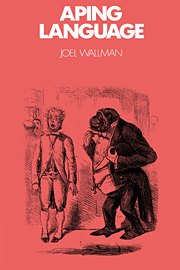Summary
This book is about the experiments carried out over the past two decades in which it was attempted to impart a language, either natural or invented, to an ape. The debate engendered by these projects has been of interest – consuming for some, passing for others – to all of those whose concerns include the enduring questions of human nature, among them anthropologists, psychologists, linguists, biologists, and philosophers.
An adequate treatment of the linguistic capabilities of apes entails consideration of a number of related issues, each of which is an interesting problem in its own right. Continuities in primate mentality, the relationship between language and thought in the individual and in the species, and the origin of language in, again, both the ontogenetic and the phylogenetic senses, are themes that will recur throughout this work. Development of parts of the argument will require moderately technical excursions into American Sign Language grammar, recursive rules in language, the neuropsychology of language, naturalistic primate communication, and language acquisition in children. A grounding in the last topic, in particular, is crucial to the argument, for the apelanguage dispute is essentially a quarrel about how similar the performance of the linguistic apes is to that of young children acquiring language.
The method followed in this book is one of detailed (though, hopefully, not tedious) critical analysis of the experimental methods and conclusions of the ape-language projects. The analysis is based on data summaries, published anecdotes, and experimenters' conclusions – in short, on published material rather than on primary data.
- Type
- Chapter
- Information
- Aping Language , pp. 3 - 9Publisher: Cambridge University PressPrint publication year: 1992
- 2
- Cited by



